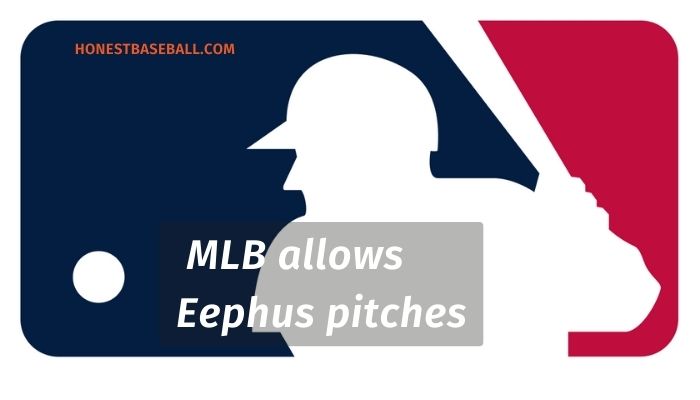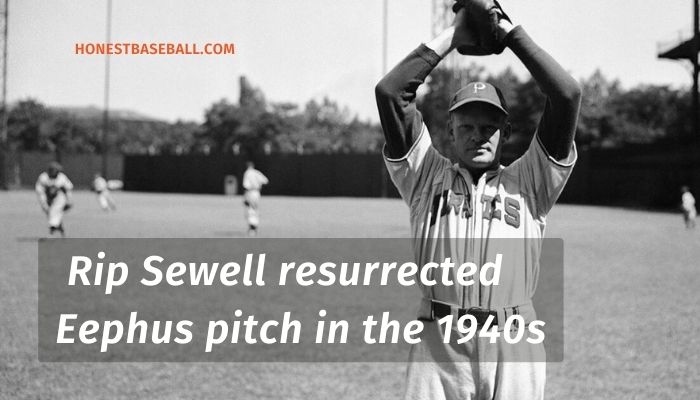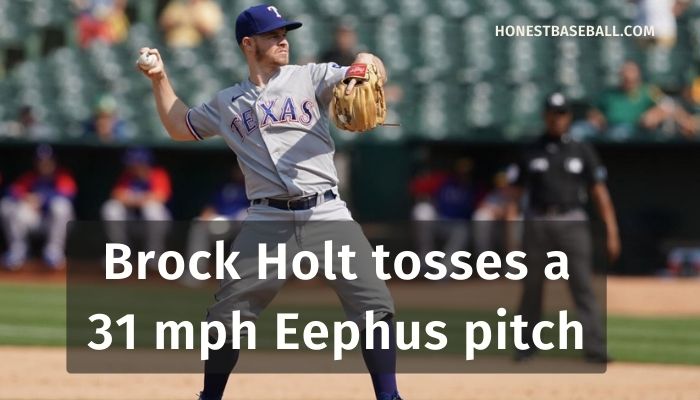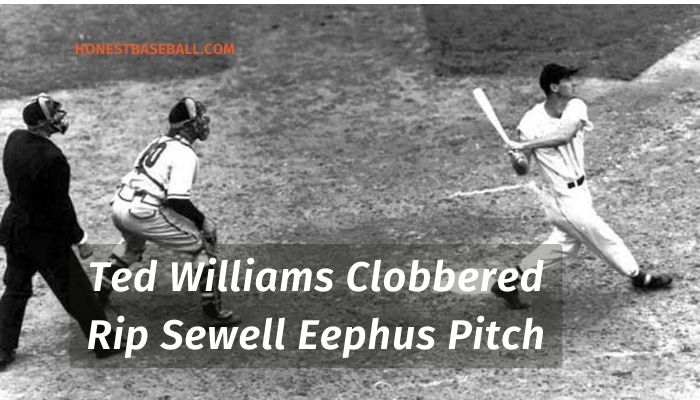Last Updated on July 24, 2022
Do you know what is an Eephus pitch in baseball?
If you are a baseball fan, you might hear the recent news in 2021 that Zack Greinke had thrown a slow delivery was around 50 mph speed. Do you already get an idea about the Eephus pitch?
Yes, an Eephus pitch is a slow baseball off-speed pitch delivery that gets significantly less speed while off to the hitter through a high arcing flight path.
There are other nicknames are called for Eephus pitches by the baseball fans. Aside from these, a lot of things to know related to Eephus pitches that are thrown from the pitcher’s mound.
So, no more late. Let’s explain the facts about Eephus pitch appears, its history, comparison with normal baseball pitches, and so on.
What Is an Eephus Pitch?

Unlike traditional baseball pitch, an Eephus pitch is the slowest pitch thrown by a pitcher. It is a kind of trick pitch that bluff the hitter off guard. You will see that the Eephus pitches are thrown overhand like traditional pitches. But, the low velocity and high traveling path make the pitcher super slow pitch.
You may also hear the phrases like overhand softball pitch, slow pitch softball, blooper ball, balloon ball, rainbow pitch, LaLob, bugs bunny curve, etc., which are used to call the Eephus pitches.
The Eephus is known as slow pitch delivery because it is thrown at a significantly lower speed. Whereas the normal baseball pitches are thrown I’m between 70 to 100 mph, most pitches of Eephus are thrown as lower as 35 to 55 mph.
Though the name Rip Sewell is attached to the invention of the slow-motion pitch, historians John thorn and John Holway name Bill Philips as the first pitcher who pitched the Eephus pitch.
Bill Phillips played baseball from 1890 to 1903 in the National League. On the other hand, Rip Sewell resurrected the slow pitch after around 40 years of Bill Phillips.
Does MLB Allow Eephus Pitch?

Yes, the answer is positive. MLB allows and legalizes the Eephus pitches in games. But, if the pitcher tries to deceive the batters with deceiving arm and pitch rotation, it’s not legal and allowed.
also, a pitcher can reduce the pitching speed as much as he wants, as there is no restriction on it.
Do you know about foul balls in baseball? An detailed explanation would help you to learn more about this. You may follow our guide on “What Is Foul Ball in Baseball? An Unforgivable Violation!” for detailed discussion.
The History of the Slow Pitch/Eephus Pitch

The Eephus pitch is first thrown by Bill Phillips in the 1890s. He was a baseball player in National League. By the way, the pitch was then developed by the hand of Rip Sewell in the 1940s afterward.
The pitch is named by the outfielder Maurice Van Robays later on. He asked the meaning of Eephus. He replied,
“Eephus ain’t nothing, and that’s a nothing pitch.”
Historians presumed that the word “eephus” came from the Hebrew language. The word אפס is the core of it and is pronounced: “EF-ess.“
By the way, Rip Sewell threw the first official Eephus in history on June 1, 1943. Sewell’s team, the Pittsburgh Pirates, played the Boston Braves in the game. Pittsburgh’s Forbes Field served as the venue for the event.
However, Sewell began working on this unique technique throughout his 1942 training season before the contest. the fantastic fact is, Sewell, obliged with 20 matches won in the year 1943 with his low mph eephus pitches.
In his 300 MLB matches, Sewell just gave a single career home run against Tedd Williams, another great of baseball. I will discuss this incident in a later section.
However, the Eephus pitch got gradual development later on. Boston Red Sox pitcher, Bill Lee threw an eephus pitch in the 1975 World Series, in the 7th match of the series. The Eephus was introduced as ‘Leephus”, ‘moon ball”, or “Spaceballs.”
By the way, the result of the game went against the Red Sox in the end. When lee threw the pitch with corresponding slow velocity, the Red Sox were up 3-0. The pitch thrown by Lee was against Tony Perez, and it resulted in a two run-run home run.
In the end, the Red Sox lost the game with a 4-3 count. This was also the loss of chance to win the World Series in 1975 since their last World Series-winning in 1918.
Do you know what are the most essential skills to learn in baseball? Let’s check the guide on “Basic Skills In baseball To Learn To Tailor The Game.”
A-List of Players Who Threw and Employed Eephus Pitches
- Fernando Abad (the super changeup).
- Pascual Pérez (the Pascual Pitch)
- Luis Tiant
- Pedro Borbón
- Orlando Hernandez
- Dave LaRoche
- Vicente Padilla (dubbed the soap bubble)
- Steve Hamilton (the Folly Floater)
- Alfredo Simon
- Casey Fossum (called the Fossum Flip), and many others.
The Slowest Pitch of Eephus in the Baseball History

The free-agent Brock Holt, an American pitcher threw some slow pitches with minimum speed for Texas Ranger. As a utility player, he has had done it on August 7, 2021. He threw the lowest speed of eephus pitch at 31.1 mph for a called strike.
The second-lowest Eephus pitch, after Brock Holt, was recorded at a speed of 46 mph. Pitcher Clayton Kershaw of the Los Angeles Dodgers threw this overhand in 2016. Due to the fact that he didn’t do this knowingly, this was not recognized as an official Eephus pitch. In contrast, the ball slid out of his hand before he was ready to throw it.
The second recorded slowest Eephus is recorded beside the name Zack Greinke. He had done this for the Houston Astros in 2021. Greinke threw his slowest pitch with a low speed of 51 mph. It was a strike pitch against the Detroit Tigers.
In the end, the ball ended up through the middle of the strike zone. As the batter got fooled, he didn’t swing the bat.
Yu Darvish threw another Eephus pitch at a pace of 59 mph.
By the way, James LeDux’s study indicates that the Eephus pitches turn at an average speed of about 60 mph.
Brock Holt comes into pitch, tosses 30 mph eephus!:
Ted Williams Clobbered Rip Sewell Eephus Pitch

The incident I have mentioned before to talk about the Sewell’s Eephus pitch with Tedd Williams is to be discussed now.
You will be amazed to know that Rip Sewell gave up just a single home run in his career off his Eephus pitch. And this is more fascinating that he did this in 300 Major League baseball matches.
The incident happened in 1946 in the MLB All-Star Game. In the middle of the game, a challenge came from Ted Williams to Rip Sewell to throw an eephus pitch.
In this situation, Sewell obliged a pitch. On the other hand, Williams fouled off the ball.
Then Rip Sewell immediately announced that he is going to throw an eephus pitch on the very next pitch again. In the end, Williams hit the ball and acquired a home run.
Later on, Williams expressed his opinion on that pitch,
“A little girl could hit that pitch, but you had to provide all the power yourself.”
After a few years, Williams recognized that he was running immediately after contacting the ball toward the pitcher’s mound. But, a photograph revealed a shocking truth behind the hit that Williams did with the Eephus pitch Sewell pitched.
The truth is, Ted Williams was a few feet ahead of the batter’s box while he was hitting the pitch. But a batter cannot do that in terms of the Official Baseball Rules of 6.06(a).
The rule says,
“A batter is out for illegal action when he hits a ball with one or both feet on the ground entirely outside the batter’s box, Williams could have been ruled out had it been spotted by the home plate umpire.”
1946 ASG: Ted Williams homers off Sewell’s eephus pitch:
By the way, Tedd Williams is one of the greatest in the history of baseball. We have a list and a brief description of the 100 greatest baseball players. You may check on the detailed guide on the “100 greatest baseball players in baseball history.”
How to Throw an Eephus Pitch?
You need to be skilled at throwing balls if you want to throw an eephus pitch.
First, grip the ball as you’re intending to throw a four-seam fastball. Make sure you crossed the baseball horseshoes with your index and middle fingers.
And keep your thumb right there on top of them. Snap your wrist as you let go of the ball to provide a backspin.
To toss the ball, you must acquire a high arc route. This will slow down the pace and throw off the hitter’s timing. Additionally, make sure that all of your pitching motions remain consistent with the standard pitches so that hitters cannot exploit you.
Frequently Asked Questions
Why is an Eephus pitch hard to hit?
Basically, hitters get optimized with the speed of the normal baseball pitches velocity. while the hitters are accustomed to the normal delivery, their subconscious mind is ready to cope with the normal velocity.
while the pitcher suddenly reduces the pitching speed, this becomes hard to go with the slow speed. Rather, the batters accustomed to speed play a fast swing here. This makes it hard to hit.
Is Eephus pitch effective?
Yes, an Eephus pitch is highly effective when it is pitched in a proper manner. Because the slow-motion pitch distracts the timing sense of the hitters.
But, you should keep in mind that throwing two consecutive Eephus pitches in a row would be a wrong decision.
Wrapping Up
Eephus is the slowest version of pitch that mostly fools the hitters and distracts their timing and attention. As a result most of the time they miss the pitch and get strikes.
However, Eephus pitches are not always that efficient. You must have a good understanding of when to deliver such a throw. Moreover, you also should not do this in a row as well.
As the Eephus pitch is in baseball for decades, it is one of the most efficient tricks for the pitchers to get a breakthrough.
You May Also Like:
How Long Does A Baseball Game Last Based On The Last 10 Seasons!
Evoshield Catcher’s Gear Review| Supreme Security Behind The Plate
How To Throw A Sinker | Learn From A Coach
How To Throw A Slider Pitchers Throw? Learn The Right Way

Hello everyone. My name is Jason Butler, and I live in California, America. I was a professional AAA Minor League Baseball player. I lost my chance of playing MLB for injury issues, but I did not lose my love for baseball. I attended the coaching training program and am now working as a coach in a small school in San Diego.
I always love to share my experience and knowledge if that can help you. Play baseball, and stay fit.
